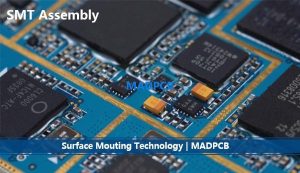Can Surface Mount Technology Be Used in Assembling Circuit Card Assemblies?
Mount Technology Be Used in Assembling Circuit Card Assemblies
Surface mount technology (SMT) is a method for assembling circuit card assemblies by mounting components on the surfaces of the printed circuit boards (PCBs). The process begins with applying solder paste to the PCB pads through stencils. Once the paste is applied, the electronic components are then placed on top of it using pick and place machines. The placement is based on the X-Y coordinates and rotation that were pre-input into the machine from the PCB design files. After the components are positioned on the PCB, the board is then passed through a reflow oven to melt and solidify the solder, forming the mechanical and electrical connections with the components.
Compared to through-hole technology, SMT offers a faster assembly time and higher component density. It also allows for greater miniaturization and better performance in harsh environments or high-frequency applications. Its assembly process can be fully automated, making it more efficient and cost-effective for high-volume production. In addition, SMT components have lower resistance and inductance at the connection point, which results in fewer unwanted RF signal effects and better high-frequency performance.
However, SMT is not suitable for all applications. The smaller size of the components and their direct contact with the surface of the PCB can make them more susceptible to physical damage during manufacturing or use. Additionally, the solder connections in SMT can be more prone to fatigue and creep failure over long periods of time.

Can Surface Mount Technology Be Used in Assembling Circuit Card Assemblies?
Despite its limitations, SMT is a widely-used technology in the electronics industry. Continuing advancements in SMT have made it more reliable and affordable for mass production, while the technology’s broader application has led to the development of innovative and advanced products across multiple industries.
circuit card assemblies (CCAs) play a pivotal role in the functionality of electronic devices, acting as the foundation upon which intricate systems are built. These assemblies, often referred to as printed circuit boards (PCBs), serve as the backbone for the interconnection of electronic components, enabling the seamless flow of electrical signals within a device. From smartphones to spacecraft, CCAs are ubiquitous in modern technology, facilitating the operation of countless electronic devices we rely on daily.
At its core, a circuit card assembly consists of a substrate material, typically a non-conductive base such as fiberglass or epoxy resin, onto which conductive pathways are etched or printed. These pathways, usually made of copper, form intricate patterns that connect various components like integrated circuits (ICs), resistors, capacitors, and connectors. The arrangement of these components and pathways is meticulously designed to achieve specific functions within the device.
Despite its numerous benefits, SMT has some disadvantages that should be taken into consideration before adopting it for production. These include the initial setup costs, ongoing operational costs, component costs, and inspection and testing expenses. To reduce the costs of SMT assembly, it is important to work with a trusted and experienced contractor that understands the technology and can offer advice on how to optimize the assembly process. Choosing a qualified SMT contracting partner will ensure that your product’s final assembly is delivered on time and within budget.








